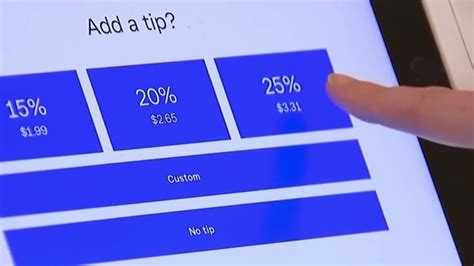
Outrage is brewing online as increasingly exorbitant tipping requests displayed on point-of-sale (POS) system screens spark widespread debate, with social media users sharing images of prompts demanding tips of up to 30% or even pre-calculated options on self-service kiosks. The surge in digital tipping, often presented before service is rendered or for transactions where tipping was traditionally uncommon, has ignited a fierce discussion about fair wages, consumer expectations, and the ethics of automated gratuity requests.
The proliferation of these screens, commonly found in coffee shops, takeout restaurants, and even retail stores, has led to what some are calling “tipflation,” where the expectation of tipping is not only expanding to more industries but also demanding higher percentages. This trend, amplified by the ease of digital payment systems like Square and Toast, has triggered a backlash as consumers feel pressured to tip even when they perceive the service as minimal or non-existent.
“It’s getting out of control,” declared one frustrated user on X (formerly Twitter), accompanied by a photo of a POS screen suggesting a 25% tip for a self-serve ice cream purchase. Similar sentiments flood social media platforms, showcasing examples of tipping prompts that many find excessive and unwarranted. These images, often humorous in their absurdity, highlight the growing tension between businesses seeking to supplement employee income and customers feeling increasingly burdened by the constant request for gratuities.
The debate extends beyond the mere dollar amount. Many argue that the automated tipping prompts are manipulative, preying on customers’ sense of guilt or social pressure to select a higher tipping option. Others raise concerns about transparency, questioning where the tips ultimately go and whether they are being distributed fairly among employees. The discussion also touches on the fundamental issue of wage structures, with some advocating for higher minimum wages to alleviate the reliance on tipping altogether.
This online frenzy reflects a deeper societal conversation about the evolving landscape of tipping and its implications for both businesses and consumers. As digital payment systems become increasingly integrated into daily transactions, the question of when and how much to tip continues to be a source of contention and frustration. The “outrageous” screens are not merely isolated incidents but rather symptomatic of a broader shift in consumer expectations and the ethical considerations surrounding automated gratuity requests.
The Evolution of Tipping Culture
Tipping, traditionally a gesture of appreciation for exceptional service, has deep historical roots. Its origins are debated, with some tracing it back to 17th-century England, where patrons of coffee houses would place money in a “tip box” labeled “To Insure Promptness.” Others suggest a medieval European origin, where servants received small payments in addition to their wages. Regardless of its precise genesis, tipping has evolved into a complex and often controversial aspect of modern economic life.
In the United States, tipping gained prominence after the Civil War, particularly in industries employing newly freed slaves. Employers, seeking to avoid paying fair wages, often relied on tipping to supplement employee income. This historical context has contributed to the enduring racial disparities in the tipping system, as certain service industries disproportionately employ minority workers.
Over time, tipping norms have become deeply ingrained in American culture, with expectations varying across different industries and regions. Restaurants, bars, and hair salons have traditionally been associated with higher tipping rates, while other services, such as retail or fast food, have typically not involved tipping. However, the advent of digital payment systems and the rise of the gig economy have blurred these traditional boundaries, leading to the proliferation of tipping requests in unexpected places.
The COVID-19 pandemic further accelerated the trend of digital tipping. As businesses struggled to stay afloat amid lockdowns and restrictions, many turned to online ordering and contactless payment systems. These platforms often included pre-calculated tipping options, encouraging customers to show their support for struggling businesses. While initially seen as a temporary measure, the prevalence of digital tipping has persisted, raising questions about its long-term impact on consumer behavior and wage structures.
The Rise of Digital Tipping and Its Implications
The widespread adoption of digital payment systems like Square, Toast, and Clover has revolutionized the way businesses process transactions. These platforms offer a range of features, including point-of-sale (POS) systems with integrated tipping prompts. While these prompts can be convenient for both businesses and customers, they have also contributed to the phenomenon of “tip creep,” where the expectation of tipping extends to a wider range of transactions.
The design of these tipping screens can significantly influence customer behavior. Pre-calculated tipping options, often presented as percentages of the total bill, can subtly nudge customers towards selecting a higher tipping amount. The absence of a “no tip” option, or its placement in a less prominent location on the screen, can further exert pressure on customers to leave a gratuity.
Critics argue that these design choices are manipulative, exploiting customers’ sense of guilt or social obligation. They also raise concerns about the lack of transparency in how tips are distributed among employees. In some cases, businesses may retain a portion of the tips to cover administrative costs or to supplement the wages of non-tipped employees. This practice, while legal in some jurisdictions, can lead to confusion and resentment among both customers and employees.
Furthermore, the proliferation of tipping prompts in self-service environments has sparked particular outrage. Customers question why they should be expected to tip when they are essentially performing the work themselves. Examples of tipping requests at self-checkout kiosks, coffee shops where customers order and pick up their own drinks, and even retail stores where no service is provided have gone viral on social media, fueling the debate about the appropriateness of digital tipping.
The legal framework surrounding tipping varies across different states and municipalities. Some jurisdictions have laws regulating how tips must be distributed among employees, while others have stricter regulations regarding the minimum wage for tipped employees. The federal Fair Labor Standards Act (FLSA) allows employers to pay tipped employees a lower minimum wage than the standard minimum wage, as long as the employees’ combined wages and tips equal or exceed the standard minimum wage. However, this “tip credit” is not allowed in all states.
The Psychological Impact of Tipping
Beyond the economic and legal considerations, tipping also has a significant psychological impact on both tippers and tippees. Studies have shown that tipping can be influenced by a variety of factors, including the perceived quality of service, the attractiveness of the server, and the social context of the interaction.
For tippers, the act of tipping can be driven by a desire to express gratitude, to conform to social norms, or to influence future service. However, it can also be motivated by feelings of guilt, obligation, or even anxiety. The pre-calculated tipping options on digital screens can exacerbate these feelings, making it difficult for customers to confidently choose a tipping amount that they feel is fair and appropriate.
For tippees, tips can provide a significant source of income and can serve as a form of validation for their work. However, reliance on tips can also create feelings of insecurity and dependence. Tipped employees may feel pressured to provide exceptional service in order to maximize their tips, even if they are not adequately compensated for their efforts.
The unpredictable nature of tipping can also contribute to stress and anxiety among tipped employees. Fluctuations in customer traffic, changes in tipping norms, and even individual customer preferences can all impact the amount of tips earned. This uncertainty can make it difficult for tipped employees to budget and plan for the future.
Alternative Models: Service Charges and Higher Wages
As the debate over tipping continues, some businesses are exploring alternative models that eliminate or reduce the reliance on gratuities. One popular option is to implement a service charge, a fixed percentage added to the bill that is used to supplement employee wages. Service charges offer greater transparency and predictability for both customers and employees, as the amount is clearly stated on the bill and the distribution of funds is typically predetermined.
However, service charges can also be controversial. Some customers may resent the mandatory fee, particularly if they are accustomed to tipping based on their own assessment of the service. Businesses that implement service charges must carefully communicate the rationale behind the change to avoid alienating customers.
Another alternative is to simply pay employees higher wages. This approach eliminates the need for tipping altogether, providing employees with a stable and predictable income. However, raising wages can be costly for businesses, particularly those operating in competitive markets. Some businesses may choose to increase prices to offset the higher labor costs, while others may opt to reduce staff or cut back on other expenses.
The debate over tipping is ultimately a reflection of broader societal values. It raises questions about fairness, equity, and the responsibility of businesses to provide their employees with a living wage. As digital payment systems continue to evolve, it is likely that the discussion about tipping will continue to intensify, leading to further experimentation with alternative models and potentially even legislative reforms.
The Future of Tipping
The future of tipping remains uncertain. While the practice is deeply ingrained in American culture, the growing backlash against digital tipping suggests that consumers are increasingly questioning its appropriateness. It is possible that the trend of “tip creep” will eventually reach a saturation point, leading to a shift in consumer behavior and a demand for greater transparency and fairness.
One potential scenario is the continued proliferation of service charges and higher wages, as businesses seek to eliminate the reliance on tipping. This would require a significant shift in mindset, both among businesses and consumers, but it could ultimately lead to a more equitable and sustainable system.
Another possibility is that digital tipping will become more sophisticated, with algorithms that personalize tipping suggestions based on individual customer preferences and the specific service provided. This could help to alleviate some of the anxiety and confusion associated with current tipping practices, but it would also raise new ethical concerns about data privacy and algorithmic bias.
Ultimately, the future of tipping will depend on a variety of factors, including technological advancements, legislative changes, and evolving social norms. As the debate continues, it is important for all stakeholders to engage in constructive dialogue and to consider the long-term implications of different approaches. The goal should be to create a system that is fair, transparent, and sustainable for both businesses and consumers.
Frequently Asked Questions (FAQ)
- Why are tipping requests appearing on screens even when I’m not receiving traditional service?
The increase in digital tipping prompts is largely due to the widespread adoption of point-of-sale (POS) systems that automatically suggest tipping options. Businesses use these systems to supplement employee income, especially in low-wage sectors, and to encourage customers to support their staff. This trend has expanded beyond traditional service industries to include self-service kiosks, takeout restaurants, and even retail stores. The COVID-19 pandemic also accelerated this trend, with many businesses using digital tipping as a way to solicit support during challenging times.
- Is it mandatory to tip when the screen prompts me to do so?
No, tipping is generally not legally mandatory in the United States, although there can be exceptions for large parties where a gratuity may be automatically added. While the screens may suggest or even pressure you to tip, you always have the right to decline. The presence of the tipping prompt doesn’t create a legal obligation to pay extra, and you should only tip if you feel the service warrants it.
- Where does the money from digital tips actually go?
The distribution of tips can vary widely depending on the business and local regulations. Some businesses distribute all tips directly to employees, while others may retain a portion to cover administrative costs, credit card processing fees, or to supplement the wages of non-tipped staff. In some cases, tips may be pooled and shared among all employees, including those in the back of the house. It’s essential to inquire with the business about their specific tipping policy if you are concerned about where your money is going. In many states, it is legally required to disclose tipping policies.
- What can I do if I feel pressured or uncomfortable with the tipping options presented on a screen?
If you feel pressured, you can always choose the “no tip” option or, if that’s not available, ask an employee to manually adjust the total. You can also voice your concerns to the business owner or manager, as customer feedback can influence their tipping policies. Additionally, you can share your experiences on social media or review platforms to raise awareness and potentially influence industry practices. Politely decline to tip if you believe the service does not warrant it.
- Are there alternatives to the current tipping system that businesses are exploring?
Yes, some businesses are experimenting with alternative models, such as implementing service charges, which are a fixed percentage added to the bill and used to supplement employee wages. Others are simply raising wages to eliminate the need for tipping altogether. These approaches aim to provide more stable and predictable income for employees while reducing customer confusion and pressure. Some restaurants have also implemented “hospitality included” models, where prices are raised to cover higher wages, eliminating the need for traditional tipping.









